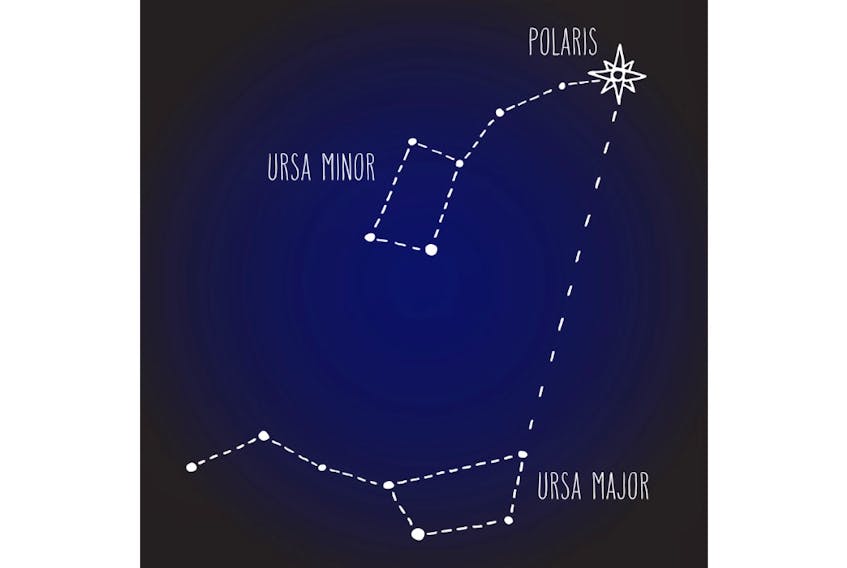A lot of people think that Polaris - the North Star - is the brightest star in the night; nothing could be farther from the truth. When giving a night sky tour to people, as I often get asked to do, and which I am more than happy to do, I have asked them to point out the north star. Invariably, they will point to one of the really bright stars in the night sky, usually Arcturus (mag. -0.05) in Bootes - the Herdsman, Vega in Lyra - the Lyre (mag. +0.02) or Sirius (the actual brightest nighttime star) in Orion - the Hunter (mag. -1.46). When I do point out Polaris to them, they are amazed that it is, in fact so dim (mag. +3.6) and difficult to find. Most people envision Polaris as extremely bright and easy to find; after all, isn’t it used for navigational purposes? Surely, the ancient navigators would have picked a much brighter star to help them find north and, consequently the other three directions.
The selection and importance of Polaris lies not in its brightness, but in its position on the celestial sphere (think of the Earth encased in a clear, outer glass shell) above us relative to the Earth. Polaris lies very close, but not exactly at what is known as “celestial north”. This is the point on the celestial sphere directly above the Earth’s rotational axis, when connected to the Earth’s surface, gives us our geographical reference of “true north”. This differs slightly from “magnetic north”, which we don’t need to worry about for the purpose of this discussion.
The sky area around the “celestial north” (as seen from Earth) is devoid of bright stars. Ancient Greek astronomers and navigators, however, found a star, though dim, that was very close to “celestial north”. Polaris comes from New Latin stella polaris, meaning “pole star”, another name for the North Star. Polaris, although the current North Star, was not always so. In the time of the ancient Egyptians, when the pyramids were being built, the star Thuban in the constellation of Draco - the Dragon was the North Star. In time (though not in our lifetime), other stars in the area around “celestial north” will become the North Star (more about that in another column).
So how do we find the North Star? Here in the northern hemisphere, that is quite easy. The majority of people can recognize and point out the asterism of the “Big Dipper” in the night sky. The Big Dipper is an asterism (think “picture within a picture”) in the constellation of Ursa Major - the Great/Big Bear. Ursa Major is one of several constellations in the night sky which are known as “circumpolar” constellations. This means they circle around the northern pole star Polaris. They are visible on any clear night, as they, at least for us here in the Maritimes, never dip below the northern horizon. Having located the Big Dipper, find the two end stars (sometimes referred to as the “pointer stars”) in the bowl of the dipper, and then connect the two with a straight line (from the bottom star to the top star), continuing the line (about 3x times the distance between the pointer stars) until you come to a semi-bright star sitting all alone; that is Polaris - the North Star. If the sky is dark enough, you will see that it is the end star in the handle of the “Little Dipper” asterism in the constellation of Ursa Minor - the Lesser/Little Bear. Dropping a line from Polaris to the horizon gives your geographical north. Facing this direction and spreading your arms out to the side gives you east on your right, west on your left, and south directly behind.
Jupiter and Saturn continue, as they have all summer, as the prime, naked-eye planets in the late evening sky, though both are setting much earlier (presently around midnight for Jupiter, and shortly thereafter for Saturn) with each passing night. Jupiter can be seen shining brightly at mag. -2.2 in the constellation of Ophiuchus - the Serpent Bearer in the SW sky at twilight. Saturn, at +0.3 mag., shines dimly off to the left of Jupiter, sitting just to the left of the handle of the “teapot” asterism in Sagittarius - the Archer. Both make excellent binocular objects in the crisp, clear night air of September. The remaining “bright planets” (those visible to the naked-eye) — Mars, Mercury and Venus — currently remain lost from sight, as they are too close to the Sun at this time to be visible in the night sky.
Don’t be put off by the lack of bright planets in the night sky this coming week. Once you have looked at Jupiter and Saturn, turn your vision to the multitude of other celestial wonders above you. Just roaming the night sky with a pair of decent binoculars will bring numerous star clusters (both open and globular) into view, not to mention the Moon. Get hold of a good star chart or planisphere, or go online, and get to know your way around the night sky (especially now that you know how to find Polaris - the North Star); there is much to see that will truly amaze you.
Until next time, clear skies.
Events:
Sept 6 - First Quarter Moon.
Glenn K. Roberts lives in Stratford, P.E.I., and has been an avid amateur astronomer since he was a small child. His column, Atlantic Skies, appears every week. He welcomes comments from readers, and anyone who would like to do so is encouraged to email him at [email protected].









